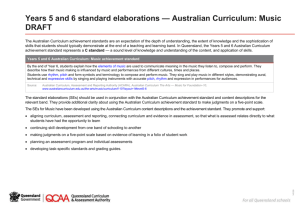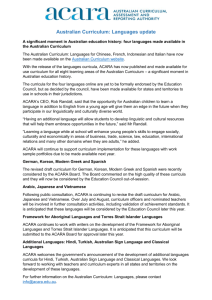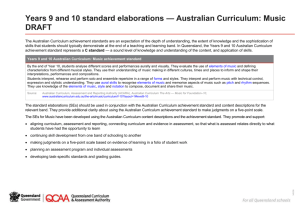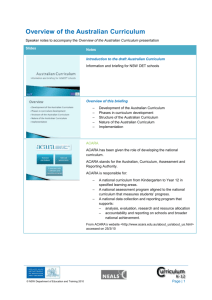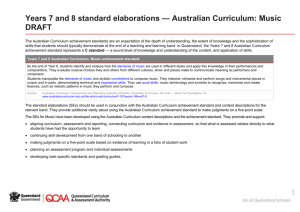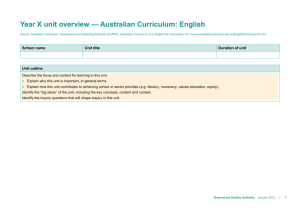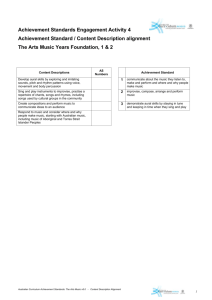Years 3 and 4 standard elaborations
advertisement
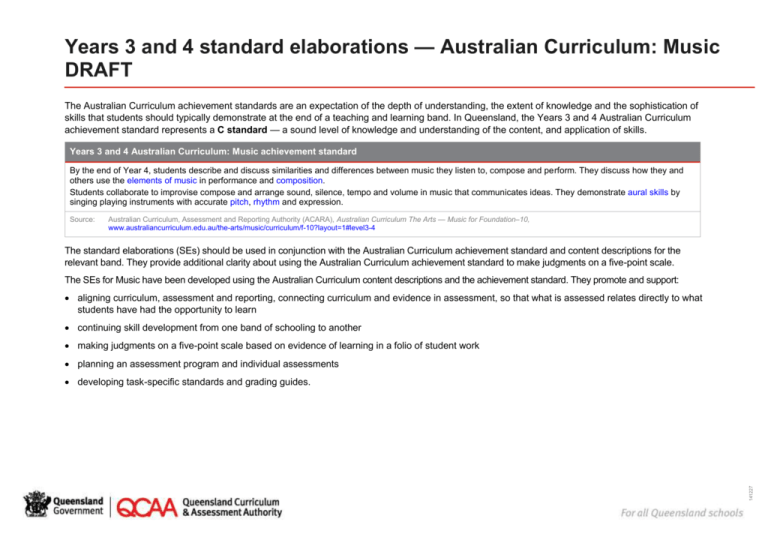
Years 3 and 4 standard elaborations — Australian Curriculum: Music DRAFT The Australian Curriculum achievement standards are an expectation of the depth of understanding, the extent of knowledge and the sophistication of skills that students should typically demonstrate at the end of a teaching and learning band. In Queensland, the Years 3 and 4 Australian Curriculum achievement standard represents a C standard — a sound level of knowledge and understanding of the content, and application of skills. Years 3 and 4 Australian Curriculum: Music achievement standard By the end of Year 4, students describe and discuss similarities and differences between music they listen to, compose and perform. They discuss how they and others use the elements of music in performance and composition. Students collaborate to improvise compose and arrange sound, silence, tempo and volume in music that communicates ideas. They demonstrate aural skills by singing playing instruments with accurate pitch, rhythm and expression. Source: Australian Curriculum, Assessment and Reporting Authority (ACARA), Australian Curriculum The Arts — Music for Foundation–10, www.australiancurriculum.edu.au/the-arts/music/curriculum/f-10?layout=1#level3-4 The standard elaborations (SEs) should be used in conjunction with the Australian Curriculum achievement standard and content descriptions for the relevant band. They provide additional clarity about using the Australian Curriculum achievement standard to make judgments on a five-point scale. The SEs for Music have been developed using the Australian Curriculum content descriptions and the achievement standard. They promote and support: aligning curriculum, assessment and reporting, connecting curriculum and evidence in assessment, so that what is assessed relates directly to what students have had the opportunity to learn continuing skill development from one band of schooling to another making judgments on a five-point scale based on evidence of learning in a folio of student work planning an assessment program and individual assessments 141227 developing task-specific standards and grading guides. Years 3 and 4 Music standard elaborations A B DRAFT C D E description and discussion of similarities and differences between music listened to, composed and performed identification of similarities and differences between music listened to, composed and performed statements about similarities and differences in music discussion of how they (as the artist) and others use the elements of music in performance and composition identification of the elements of music they (as the artist) and others have used in performance and composition statements about the elements of music improvisation, composition and arrangement of music that communicates ideas, through use of: expression sound and silence tempo volume improvisation, composition and arrangement of music that communicates ideas, through uneven use of aspects of: expression sound and silence tempo volume presentation of music, with sporadic use of aspects of: informed description and informed discussion of similarities and differences between music listened to, composed and performed thorough discussion of how they (as the artist) and others use the elements of music in performance and composition informed discussion of how they (as the artist) and others use the elements of music in performance and composition Composing improvisation, composition and arrangement of music that is cohesive and clearly communicates ideas, through skilful and effective use of: expression sound and silence tempo volume improvisation, composition and arrangement of music that communicates ideas, through effective use of: performance of music that is cohesive and clearly communicates ideas, with demonstration of aural skills through skilful, effective and sustained use of: accurate pitch accurate rhythm expression. performance of music that clearly communicates ideas, with demonstration of aural skills through effective use of: performance of music that communicates ideas, with demonstration of aural skills through use of: performance of music that communicates ideas, with demonstration of aural skills through uneven use of aspects of: performance of music, with sporadic use of aspects of: accurate pitch accurate rhythm expression. accurate pitch accurate rhythm expression. pitch rhythm expression. pitch rhythm expression. Making Knowledge, understanding and skills Responding thorough description and thorough discussion of similarities and differences between music listened to, composed and performed Performing The folio of student work has the following characteristics: expression sound and silence tempo volume Years 3 and 4 standard elaborations — Australian Curriculum: Music DRAFT expression sound and silence tempo volume Queensland Curriculum & Assessment Authority February 2015 Page 2 of 6 Key Shading emphasises the key aspects of the achievement standard and qualities that discriminate between the A–E descriptors. Key terms are described overleaf. Years 3 and 4 standard elaborations — Australian Curriculum: Music DRAFT Queensland Curriculum & Assessment Authority February 2015 Page 3 of 6 Notes Examples of knowledge and skills in Years 3 and 4 Music ACARA provides examples of knowledge and skills in Music across each band, and they are provided here for your reference. Years 3 and 4 In this band students develop their knowledge of how ideas and intentions are communicated in and through music. They build on and refine their knowledge, understanding and skills through music practices focusing on: elements of music - rhythm simple metres, crotchet, crotchet rest, quaver, semiquaver dotted crotchet, quavers in groups of three and identical rests in repertoire studied ostinato, tempo changes (faster and slower) - pitch pentatonic patterns, melodic shape, recognising steps and leaps, treble clef, staff - dynamics and expression very soft (pianissimo) pp and very loud (fortissimo) ff, gradually getting louder (crescendo), gradually getting softer (decrescendo), smoothly, short and detached - form question and answer (call and response), repeat signs, binary (AB) and ternary (ABA) forms - timbre recognising familiar instrumental timbres in isolation and combination - texture combining two or more rhythmic or melodic patterns which occur simultaneously in different voices skills (including aural skills) - matching pitch and showing the direction of a tune with gesture or drawings - recognising the differences between notes moving by steps and leaps - discriminating between rhythm and beat - demonstrating beat and tempo changes - matching and varying dynamics - varying instrumental timbres to create expressive effects using instruments and voices safely and correctly in the classroom - taking on different roles in group music making, for example, accompaniment, lead - using technology as a tool for music making and performance. (ACARA, Examples of knowledge and skills in Music, www.australiancurriculum.edu.au/the-arts/music/examples#3-4) Years 3 and 4 standard elaborations — Australian Curriculum: Music DRAFT Page 4 of 6 Queensland Curriculum & Assessment Authority February 2015 Australian Curriculum valued features The SEs describe the qualities of achievement in the two valued features for Australian Curriculum Arts achievement standards — responding and making. Valued features Description responding includes exploring, responding to, analysing and interpreting artworks making includes learning about and using knowledge, skills, techniques, processes, materials and technologies to explore arts practices and make artworks that communicate ideas and intentions Terms used in Years 3 and 4 Music SEs The following terms are used in the Year 3 and 4 Music SEs. They help to clarify the descriptors, and should be read in conjunction with the ACARA Music glossary: www.australiancurriculum.edu.au/the-arts/music/glossary. Term Description arranging; arrange in Music, to organise and structure musical ideas for a particular purpose artist generic term for the maker of an artwork in each of the five arts subjects; in Music, the artist is performer or composer aspects particular parts or features aural skills in Music, particular listening skills students develop to identify and discriminate between sounds; also referred to as ear training which involves focused listening activities through with students identify sounds such as rhythm, pitch and timbre; see ACARA’s Examples of knowledge and skills in Years 3 and 4 Music clearly easy to perceive, understand, or interpret cohesive characterised by being united, bound together or having integrated meaning collaborate to work jointly on an activity or project; in Years 3 and 4 Music, students work collaboratively to improvise, compose and arrange sound, silence, tempo and volume composition the placement or arrangement of elements or parts in artworks description; describe give an account of characteristics or features discussion; discuss talk or write about a topic, taking in to account different issues or ideas dynamics and expression in Music, refers to how the sound is performed, including sound qualities (e.g. the relative volume and intensity of sound); see ACARA’s Examples of knowledge and skills in Years 3 and 4 Music effective meeting the assigned purpose in a way that produces a desired or intended result; in Music, meeting the purpose by producing a strong impression Years 3 and 4 standard elaborations — Australian Curriculum: Music DRAFT Page 5 of 6 Queensland Curriculum & Assessment Authority February 2015 Term Description elements of music in Music, the elements of music are: rhythm: (including tempo and metre): the organisation of sound and silence using beat, rhythm and tempo (time) pitch: the relative highness or lowness of sound; pitch occurs horizontally (as in a melody) and vertically (as in harmony) dynamics and expression: the relative volume (loudness) and intensity of sound and the way that sound is articulated and interpreted form and structure: the plan or design of a piece of music described by identifying what is the same and what is different and the ordering of ideas in the piece timbre: the particular tone, colour or quality that distinguishes a sound or combinations of sounds texture: the layers of sound in a musical work and the relationship between them; see ACARA’s Examples of knowledge and skills in Years 3 and 4 Music form in Music, form is the sections within a piece of music, e.g. binary form (AB) contains section A, then section B ternary form (ABA) contains section A, section B, then return to section A rondo form (ABACA) contains section A, section B, section C, then return to section A; see ACARA’s Examples of knowledge and skills in Years 3 and 4 Music identification; identify establish or indicate who or what someone or something is informed having relevant knowledge; being conversant with the topic; in Music, this includes how the knowledge and skills (elements of music, conventions of form, instrumental techniques, ensemble skills, aural skills) work together to communicate meaning or intent in and through music performing music in Years 3 and 4 Music, singing and playing instruments pitch in Music, the highness or lowness of a sound; see ACARA’s Examples of knowledge and skills in Years 3 and 4 Music rhythm in Music, combinations of long and short sounds that convey a sense of movement subdivision of sound within a beat; see ACARA’s Examples of knowledge and skills in Years 3 and 4 Music skilful in Music, in the context of: creating artworks, this includes considered selection, management and application of the elements of music sharing artworks, this includes a high degree of proficiency and polish sporadic appearing, happening now and again or at intervals; (irregular) or occasional statement; state a sentence or assertion sustained continuing for an extended period or without interruption thorough demonstrating depth and breadth of music knowledge and skills timbre the particular tone, colour or quality that distinguishes sound or combinations of sounds; see ACARA’s Examples of knowledge and skills in Years 3 and 4 Music uneven not properly corresponding or agreeing; not in keeping with Years 3 and 4 standard elaborations — Australian Curriculum: Music DRAFT Page 6 of 6 Queensland Curriculum & Assessment Authority February 2015
